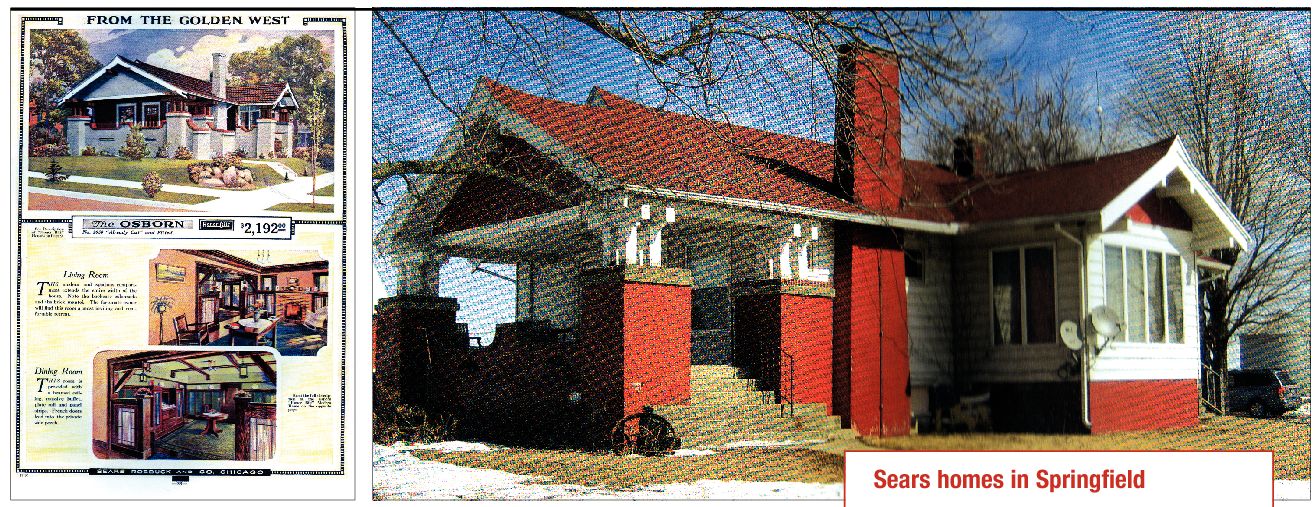
The catalogue page illustrating The Osborn model of Sears home and, right, an example of the home, built in 1928. For an extra $148 you could upgrade from pine to oak millwork in the living and dining rooms.
Sears homes in Springfield
Here’s
a partial list of probable and possible Sears houses in Springfield,
along with the Sears model name. They were identified by Rosemary
Thornton in 2003 and kept by the Sangamon Valley Collection at Lincoln
Library. The numbers following the listing from one to ten indicate
Thornton’s feeling about the likelihood of the house being a Sears
product, with one being least likely and ten most likely.
928
N. First, Bellewood, 9; 1450 N. Fourth, Hazelwood, 10; 1417 S. Fourth,
Americus, no rating; 2048 S. Fourth, Savoy lookalike, no rating; 2104 N.
Fifth, Winona, 5; 2001 N. Seventh, Crescent, 6; 2021 N. Seventh, Dover,
8; 2069 N. Seventh, Dover, 7; 1516 Bates, Avondale, 9; 524 W.
Carpenter, White Hall, 9; 617 E. Cedar, Crescent, no rating; 715 Fayette
(Aladdin Co.), Cadillac, 8; 1032 Fayette, Arcadia, 9; 900 S. MacArthur,
Osborn, 9; 704 W. Vine, Lewis, no rating.
The American Dream, pre-cut and ready to assemble
BOOK REVIEW | Corrine Frisch
Nearly 10 years ago Rosemary Thornton drove to Springfield from Alton to give a talk at Lincoln Library about Sears homes. As the library’s program director, I remember her coming early in the day so we could drive through various Springfield neighborhoods “hunting.” Our game? The elusive “Savoy,” “Kilbourne,” “Ashmore” or “Oakdale.” Reading her new book, Sears Homes of Illinois, I recalled that pleasant afternoon, and how excited she was when she spotted what might be an object of her affection. Ms. Thornton has the winning authorial combination – a way with words and a passion for her subject.
The library lecture was one of hundreds she has given over the past decade. We had a good turnout which surprised me because I had never heard of Sears homes. No surprise that the audience was on the far side of 50, as these pre-cut, unassembled houses that you could buy out of a catalog, were manufactured and sold between 1908 and 1940. Several of the attendees carried pictures, sure that their house or the one they had grown up in was indeed a Sears home.
The automobile and train had much to do with the popularity of what some may mistakenly describe as pre-fab houses. The automobile because, as its popularity grew, people could move out of the center of town to the suburbs – and the train because it took an entire boxcar to hold the 12,000+ pieces of the home to be fit together by the new owners (and you thought hanging wallpaper together was a challenge).
Illinois was the hub of the industry. Sears owned a lumberyard at the confluence of the Mississippi and Ohio rivers in Cairo (to Illinoisans that’s pronounced like the corn syrup). It wasn’t just any pile of wood. The lumber was fine yellow pine from first-growth forests; the wood was denser than the construction lumber we would see today. Sears ensured and guaranteed its quality by storing it under a roof, out of the weather. As a result, there are many Sears homes still standing in the little town at the tip of Illinois.
My one disappointment in the book is that there are no Springfield homes pictured. This is a minor complaint. The book is beautifully illustrated with color photos and reproductions from the original catalogs. The homes are in clusters throughout the state with a wealth of them in Wood River, Carlinville and Schoper. Standard Oil had operations in these towns and in 1918 ordered 192 homes to house its workers – more than a million dollars worth of the American dream. There are also many houses in Elmhurst, and some in rural areas (Sears also sold barns and outbuildings).
At the height of their popularity, Sears sold 342 homes in one year. That was big business and big money. Over the years the homes ranged in price from the very modest Hudson, at $474, to the show-stopping Magnolia, a beautiful colonial revival coming in at $6,488.00 (not including cement, brick or plaster). The most popular styles were Cape Cods, neo-Tudors, bungalows, Colonial and Dutch revivals.
Looking at pictures of the Sears homes one can see why they are difficult to spot. They look fairly identical to the “stick built” houses of the same eras. Given that fact, one also must take into consideration the changes a house undergoes in 90 years. Sometimes the alterations are done tastefully in keeping with the original plan. Other times the home undergoes what Ms. Thornton calls “remuddling,” porches torn off, trim dismantled or the ubiquitous coat of aluminum or vinyl siding. For the untrained eye the author includes a detailed, 8-step process to determining if you might own one of these jewels.
At one of her early lectures in Champaign, Ms. Thornton tells of an elderly woman in a wheelchair, holding a bundle which turned out to be the original catalog and blueprints of her parents’ “Osborn.” At $2,192, this attractive bungalow had built-in bookcases and wood wainscoting. Mrs. Riggs had lived in the house, just south of Sidney, Ill., since 1928. The papers had been carefully preserved except that there was a hole in the middle of the catalog page featuring a description of the home. “Mother didn’t want anyone to know how much she paid,” she explained.
Sears homes are a piece of Americana that might have been forgotten if not for the efforts of Rosemary Thornton. Her book is a testament to her research, lovingly and skillfully accomplished.
Corrine Frisch, former public relations director of Lincoln Library, is an occasional Illinois Times contributor. She lives in restored bungalow (not a Sears home) in Springfield’s historic Hawthorne Place. Contact her at [email protected].